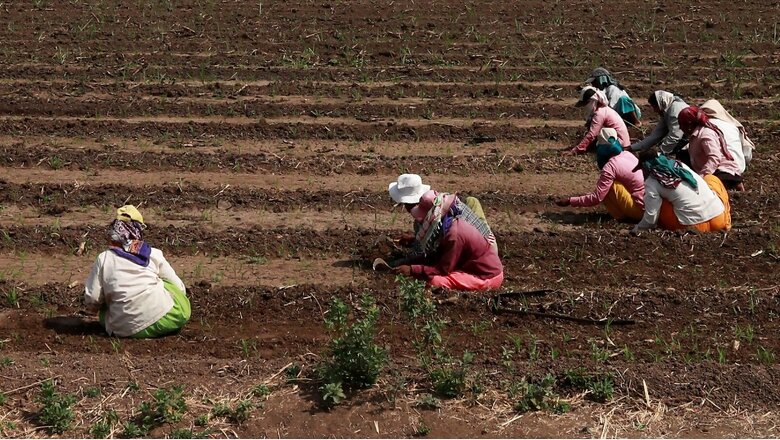
views
The 2022 report by the Intergovernmental Panel on Climate Change (IPCC) highlighted the immediate need for climate adaptation and identified ecosystem-based adaptation that collaborates with local communities as one of the main approaches to achieve this. For India, the cultivation of homegrown millets, which are indigenous to our local cultures and geographies, is a perfect example of an ecosystem-based approach.
These sturdy crops – local, resilient against drought and floods, with the potential to provide nutritional and livelihood security – could be the perfect ally in our fight against climate change.
Incidentally, Union Budget 2022 has called for special provisions for the support of post-harvest value addition and branding of millet products – a proposal that is well-timed and will help provide a road map for millets and move towards a sustainable agriculture policy. Millet cultivation has seen a revival in India recently, thanks to government support and the rebranding of millets as “nutri-cereals”.
Several initiatives have been undertaken in the last few years to promote millets. The Initiative for Nutritional Security through Intensive Millet Promotion (INSIMP), launched as part of the Rashtriya Krishi Vikas Yojana in 2012, provided an impetus to farmers through technology demonstrations, provision of inputs, financial assistance, and aid in post-harvest value addition. The scheme helped pave the way for the millet missions which were adopted by several states.
Also Read: One Size Fits All Will Not Work, Indian Agriculture Needs Decentralised Farm Reforms
The 2017 Odisha Millet Mission is a noteworthy example. It has promoted millets in rural areas through improved agronomic practices, setting up decentralised processing facilities, and most importantly, fostering its consumption at the household and macro level. In its very first year, the millet yield per hectare increased by 119.8% and the value of production per hectare more than doubled from Rs. 9,447 to Rs 20,710.
Chhattisgarh’s millet mission has focused on input assistance and ensuring better prices for farmers. Madhya Pradesh is drawing up a millet policy in association with civil society groups to amplify support for minor millets such as kodo and little millet (kutki). However, some issues – like poor consumer demand, lack of facilities for value addition, low remuneration for farmers, and inadequate input subsidies – persist. The complexity and severity of the issue have spurred various institutions and organisations to work on finding solutions.
A private philanthropic organisation, for instance, has contributed significantly to the social and economic development of farmers, promotes millets, among other crops. It has supported millet cultivation in 15.5 hectares in five districts of Uttarakhand. Farmers received training in millet cultivation practices, integrated plant nutrient management and use of community post-harvest machinery. A state-level producer company, Trishulii, was also formed. It comprises 20 women’s cooperatives, had a yearly revenue of nearly Rs 6 lakh in 2021 and its outreach covers more than 1,500 self-help groups (SHGs) and around 20,000 households.
There have been production-related innovations in millets as well, steered primarily by an international organisation that conducts agricultural research for rural development. New, improved varieties of pearl millet have been introduced across Haryana and Rajasthan. It is now being grown in more than 800,000 hectares in these states. The early-maturing and disease-resistant variety has prevented annual losses of USD 8 million, and led to a 15% increase in grain yield.
At the market and business front, an agricultural research institute has set up an incubation programme for “nutri-cereal” startups. The program provides technical consultancy and access to funding and infrastructure facilities to support business. This has helped improve consumer demand with the introduction of nearly 380 millet-based products in the market. At a more grassroots level, a non-profit that seeks to increase employment opportunities for poor women in rural areas, has been working in Kolli Hills, Tamil Nadu, for over three decades to promote traditional millet farming through women’s collectives. It has supported more than 35 SHGs with around 390 members, of which 214 are women, to institutionalise various millet operations, including the millets value chain.
As for the intervention across the value chain of millets, a social enterprise that supports community-based natural food products, has connected more than 20,000 farmers and 20 artisanal producer organisations to bring premium food products to the market, including millet-based products. It has established a value chain of trust through its geo-tagged system to help track the origin of the products, and the “know your farmer” sticker on the products that helps take the farmer’s story to the consumer.
These organisations and institutions have substantially contributed to the millet sector by raising crop productivity, improving consumer demand, and increasing farmers’ incomes. Despite the significant progress, problems remain. In rural India, millets are not provided as part of the Public Distribution System (PDS) like rice and wheat under the National Food Security Act, which in turn drives down consumption. The root of the problem is that the selective use of crops during the Green Revolution led to a decline in millet cultivation, and this affected agro-biodiversity and nutritional security. As 2023, the International Year of Millets, draws closer, the need to improve the millet value chain, increase public awareness about the health benefits and increase the demand for millets, is more pressing. More organisations should lend their support and expertise to the millet sector. The government must put a system in place to help form a strong private-public nexus to propel India towards a radiant and nutrient-rich future with millets.
Madhu Verma is the Chief Economist, Parul Sharma is the Lead Researcher and Anjaney Singh is a consultant at the Economics Center, WRI India. The views expressed in this article are those of the authors and do not represent the stand of this publication.
Read all the Latest Opinion News and Breaking News here


















Comments
0 comment